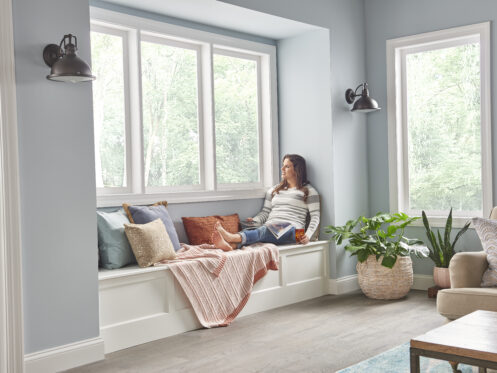Managing a single thermostat can lead to a home being too hot or too cold to keep one room comfortable. Zoned HVAC systems let you tailor settings for different areas, so you’re never overheating the guest room just to warm the den. At Air Authority, A Riteway Service Company, in San Antonio, TX, we guide homeowners through choosing the right zoning layout that considers their budget, lifestyle, and heating and cooling needs.
How Zoning Works
Zoned HVAC systems divide your home into separate areas, each controlled by a damper in the ductwork. When you set different temperatures for upstairs bedrooms and the living room, dampers adjust airflow so only the spaces you want get conditioned air. A single heating or cooling unit continues to run, but a zoning panel tells each damper when to open or close. That way, you’re not pumping heated or cooled air into an empty room all day.
In homes with tall ceilings or long hallways, you’ll notice that individual rooms hit your target temperature more quickly, since airflow is focused rather than diluted. Our team installs and programs your zone system so it recognizes your thermostat settings and directs the dampers correctly. You gain precise control over how and when each zone receives warm or cool air, minimizing wear on your HVAC components and cutting down on uneven hot and cold spots throughout your home.
Comfort in Every Corner
With zoning, you no longer must accept a chilly landing upstairs or a sweltering sunroom in the afternoon. You choose the temperature for each area based on your preferences. For example, you might set the kitchen five degrees lower during mealtimes when cooking equipment adds extra heat. You can raise it again once dinner is over and your home cools. This flexibility stops you from raising the temperature through your whole house to address one hot spot.
You can also create dedicated nighttime settings in bedrooms, keeping them cooler while living spaces stay at a cozier level. That targeted approach fits perfectly if you have different comfort preferences in your household. Senior family members who feel colder can have their own zone with warmer temperatures, while children who prefer a cooler bedroom sleep more soundly. When everyone controls their own space, complaints about thermostat battles fade away, and comfort feels customized.
Energy Savings in Practice
Focusing on heating and cooling where you need it most reduces wasted runtime. In a zone setup, if you spend your daytime hours in a home office and leave the rest of the house cooler, you see lower energy use compared to running the system for the entire home footprint. Zone control also prevents short-cycling, which can happen when large spaces demand more air than a single thermostat setting can provide efficiently.
By directing airflow to one or two zones at a time, your compressor and blower fan run at steadier speeds, drawing less power per minute. Homeowners often report noticeable drops in their monthly bills when they switch from whole-house control to zoning. This is especially true in spring and fall when you might only use one or two zones.
Integration With Smart Controls
Modern zoning panels link seamlessly with smart thermostats and home automation platforms. You can set personalized schedules that align with mealtimes, work hours, and bedtime across each zone. If your smart assistant notes you’ve left the house, it can lower the temperature in living areas while maintaining a minimal climate in rooms with pipes or pets. Geofencing features on your phone tell the zoning panel you’re on your way home, prompting a gentle temperature rise in main areas.
Impact on Indoor Air Quality
Zoned systems let you manage ventilation in each section of your home. If one zone battles humidity from a frequently running washing machine, you can program the damper to open more frequently. This promotes better airflow in that area while keeping other zones sealed. Your dehumidifier or fresh-air intake focuses on the trouble spot without overloading the rest of the system. You also reduce dust and pollen movement by closing zones to block airflow when outdoor conditions worsen.
Homeowners with allergy concerns find relief because they can direct filtration efforts to bedrooms at night. This lowers concentrations of particulate matter where it matters most. A well-balanced zone setup prevents stale pockets of air, since each zone cycles through its own conditioning and ventilation routine. You end up with fewer contamination issues and a more balanced relative humidity level throughout the house.
Zoning Installation Considerations
Adding zoning is more than bolting on dampers. Our team maps out duct runs to identify central trunk lines and individual branches for each zone. We calculate airflow requirements, ensuring each damper doesn’t dramatically reduce air flow in a specific zone or overload another area. You might need a larger blower motor or an upgraded air handler to support the additional backpressure from closed dampers. The zoning panel requires a clear location near your air handler, with wiring to each thermostat and power to each damper motor.
Professional installers take measurements of each room’s load and match damper sizes so you get the right volume of air where you need it. We also test each zone independently, calibrating the panel to avoid conflicts when multiple zones call for heating or cooling at once. Careful planning avoids noise and pressure imbalances, so your system runs quietly and efficiently.
Long-Term Maintenance Benefits
Zoned systems reduce wear on compressors and blowers because they run longer at moderate speeds rather than short, high-stress cycles. This leads to fewer repair calls and extends equipment life. You still change filters and keep coils clean, but you also inspect each damper actuator at annual service visits to confirm it aligns fully open or closed.
Seals on damper blades get checked for air leaks, preserving the seal between zones. If you notice one zone underperforming, we can isolate the issue down to a single damper rather than your entire system. That targeted diagnosis often leads to faster service calls and lower labor costs. With proper upkeep, zoned HVAC continues delivering balanced comfort and efficiency through each season without the strain a single thermostat system can cause.
Enhancing Zoning With Supplemental Solutions
Pair zoning with supplemental solutions such as variable-speed blowers or modulating furnaces to refine comfort further. Variable-speed blowers adjust airflow by increments, so when only one zone calls for air, the system throttles back rather than shutting off. That steady airflow maintains temperature and keeps humidity in check. If you have a modulating gas furnace, the burner adjusts output in small steps, matching the exact heat demand of active zones. This prevents temperature swings and reduces fuel consumption.
Adding heat pump supplemental valves in specific zones can also boost heating capacity during cold snaps without firing up the whole-house furnace. These layered approaches work together, giving you a finely tuned system that adapts smoothly as your daily routine shifts from morning to night or weekend to workday.
Custom Climate Comfort Starts Here
Zoned HVAC systems transform a one-size-fits-all approach into room-by-room control. This pairs perfectly with smart thermostats and seasonal tune-ups. You can add services like duct sealing to maximize each zone’s performance or install air quality monitors that link to your dampers for healthier airflow.
If you’re ready to enjoy personalized comfort throughout your home, contact Air Authority, A Riteway Service Company in San Antonio today to explore a zoning solution designed just for your modern home.





